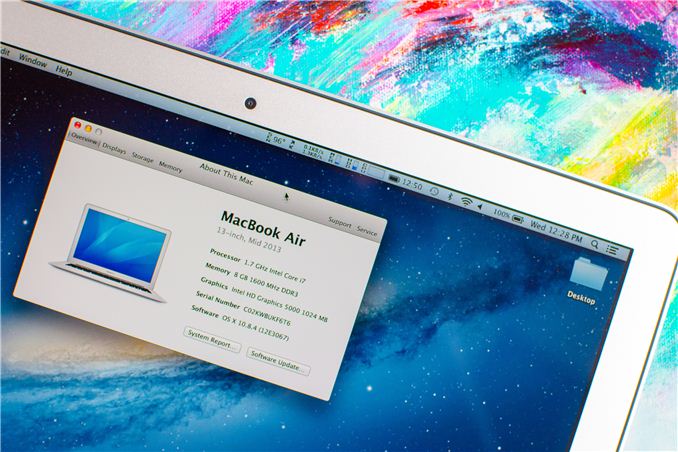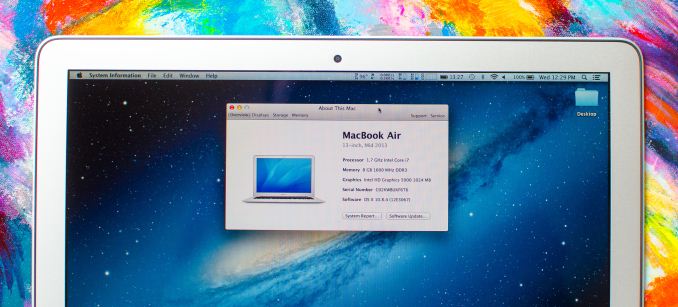The 2013 MacBook Air: Core i5-4250U vs. Core i7-4650U
by Anand Lal Shimpi on July 4, 2013 8:00 AM EST
Apple typically offers three different CPU upgrades in its portable Macs: the base CPU, one that comes with the upgraded SKU and a third BTO option that's even faster. In the case of the 2013 MacBook Air, Apple only offered two: a standard SKU (Core i5-4250U) and a BTO-only upgrade (Core i7-4650U). As we found in our initial review of the 2013 MacBook Air, the default Core i5 option ranged between substantially slower than last year's model to a hair quicker. The explanation was simple: with a lower base clock (1.3GHz), a lower TDP (15W vs. 17W) and more components sharing that TDP (CPU/GPU/PCH vs. just CPU/GPU), the default Core i5 CPU couldn't always keep up with last year's CPU.
For most users upgrading from an older machine the regression won't matter. The 2013 MBA includes a much faster SSD, better graphics, and better CPU performance compared to older MBAs as well. For those users who are either trying to make an ultraportable more of a workhorse, or who otherwise need more performance than last year's MBA can offer there is one solution. The BTO upgrade increases the base clock to 1.7GHz, adds an extra 1MB of L3 cache and includes much higher turbo frequencies:
| Apple 2013 MacBook Air CPU Comparison | |||||
| 1.3GHz dual-core | 1.7GHz dual-core | ||||
| Standard On | 11 & 13-inch MBA | Optional on Both | |||
| Intel Model | Core i5-4250U | Core i7-4650U | |||
| Base Clock Speed | 1.3GHz | 1.7GHz | |||
| Max SC Turbo | 2.6GHz | 3.3GHz | |||
| Max DC Turbo | 2.3GHz | 2.9GHz | |||
| L3 Cache | 3MB | 4MB | |||
| TSX-NI | No | Yes | |||
| TXT | No | Yes | |||
| AES-NI | Yes | Yes | |||
| VT-x/VT-x EPT | Yes | Yes | |||
| VT-d | Yes | Yes | |||
| TDP | 15W | 15W | |||
| Processor Graphics | Intel HD 5000 | Intel HD 5000 | |||
| GPU Clock (Base/Max) | 200/1000MHz | 200/1100MHz | |||
Careful binning makes all of this possible within the same TDP and cooling solution as the standard configuration.
The CPU upgrade comes at a fairly reasonable cost: $150 regardless of configuration. The max clocks increase by almost 30%, as does the size of the L3 cache. The obvious questions are how all of this impacts performance, battery life and thermals. Finally equipped with a 13-inch MBA with the i7-4650U upgrade, I can now answer those questions. The two systems are configured almost identically, although the i7-4650U configuration includes 8GB of memory instead of 4GB. Thankfully none of my tests show substantial scaling with memory capacity beyond 4GB so that shouldn't be a huge deal. Both SSDs are the same Samsung PCIe based solution. Let's start with performance.











127 Comments
View All Comments
eanazag - Friday, July 5, 2013 - link
Zero innovation? I am neither for or against. Though how often do companies release a new product missing features that they had enough time to roll out. Apple is fairly consistent at rolling out products with a technology first. Name another laptop with a PCIe SSD. There are a handful with AC WiFi. And Apple is on the front end of anyone releasing a design with Haswell. I am not going to ignore that the fact is the chassis is the same, but they weren't doing bad with it to begin with. The reality is that to hit 12 hours of battery life the performance was about the same as last year's model. The question was for someone buying a Mac, was there even an option that didn't destroy the battery life gains.The "best Mac laptop" article was geared towards consumers buying a Mac. It wasn't for everyone. I would not buy a Mac today. Gaming is not adequate for me and buying a title that can still run on my Windows desktop at the same time is a better choice.
I would only buy Macs for specific use cases. Maybe editing media. Though I do like Sony Vegas on the PC.
Finally, there are articles that I routinely skip because the topic doesn't interest me much at all. I would suggest you develop that skill as it will likely help you in life more than being a complainer.
jack daniels esq - Friday, July 5, 2013 - link
God - I love this f**cking sitenegativeions - Saturday, July 6, 2013 - link
It's amazing how many anandtech and apple losers post on here. Don't you morons know that these people are just company PR. Apple rips people off blind. Are their computers nice to use. Sure. I love them. But Apple are goons.antonio22m - Wednesday, August 14, 2013 - link
Macbook Air is undoubtedly a very good notebookPrice and lack of optical drive can affect a large number of users whose decision during the judgment can be negative so that they can decide to choose another manufacturer.
Air is perfect and the best "second computer" that you can wish for.
His task was not to be the main and only computer we can possess.
If you want excellent laptop computer that will be able to carry it with you wherever you go, the Air is an excellent choice for perfectly reasonable size and more pronounced weight that barely exceeds one kilo.
Take a look at this comparison at http://www.squidoo.com/apple-macbook-air-133 and You will see comparison to the another Apple laptops.Anyone considering purchasing this laptop needs to see the information in this chart.
helloworldv2 - Thursday, July 4, 2013 - link
In my opinion, your light workload battery life test doesn't represent real life. Under my perceived light load usage (Word open, a few tabs in Firefox, running a few algorithms in terminal), I've seen 7-8 h battery life with the maxed out 13" model..DanNeely - Thursday, July 4, 2013 - link
Everyone's idea about what is a light workload is different. A few years ago when my Laptop of the time was benched on AT, I was able to beat their light load numbers by about 10-15% on a test that was much less demanding than the current one.melgross - Thursday, July 4, 2013 - link
We all have our own workloads. Anand, and other testing sites make these loads up to represent what they think is approximately the average for light, medium and heavy workloads. For your usage, you seem to fall to the medium workload, even though you call it light.For others, light is just using a browser with a handful of tabs.
The poi t to their workloads is to have a standard that they can compare machine to machine. Don't take it as more than that, and for somethi g that people can look at and figure where their workload falls within the least and the max tests.
FwFred - Thursday, July 4, 2013 - link
What is your screen brightness? A few algorithms? Is this code which continuously runs (not good for CPU power management)? If anything, Anand is getting on the lower end of the range others are seeing, primarily because he sets his screen to 200 nits which is higher than others.helloworldv2 - Thursday, July 4, 2013 - link
Brightness is on auto. A few algorithms might be anything between querying a sequence database and making multiple sequence alignments or whatever, utilizing both cores 100% for a brief period. Nothing too heavy (that's what ssh and clusters are for).FwFred - Thursday, July 4, 2013 - link
I have a 2011 MBA, and while the brightness is using the 'auto' selection, you can still set the percentage. Which percentage do you have it? The auto setting will vary the backlight based on the ambient light, but the percentage still affects the result. I am at ~70%, and I can say that 100% is very noticeably brighter.